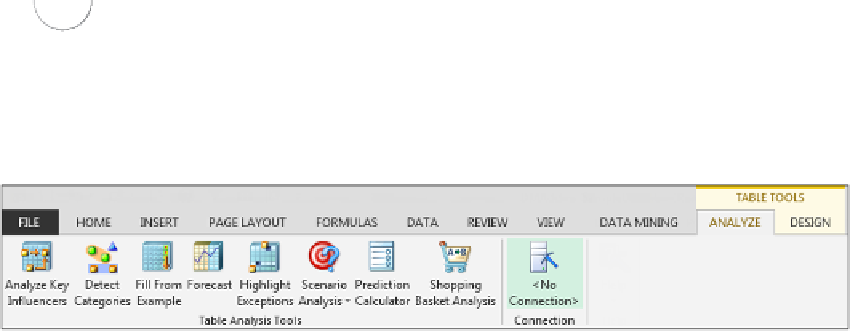Database Reference
In-Depth Information
The full breadth of functionality that comes with the Data Mining Add-In is staggering. There are
many features of the add-in you will likely never touch. Instead of focusing on all aspects of the Data
Mining Add-In, the remainder of this chapter discusses the features found in the Data Mining Table
Analysis Tools.
The Table Analysis Tools is an ideal set of analytical features if you aren't a data mining expert, but you
need to perform complex pattern recognition and predictive analytics.
It's important to note that you can use data from almost any source with the Data
Mining Add-In. The data does not have to come from SQL Analysis Services. That being
said, to use the Table Analysis Tools, you need to convert your data ranges to named
Excel tables. Click anywhere inside your data range and press Ctrl+T. In the Create Table
dialog box, ensure that the range for the table is correct and then click OK.
Note
Click anywhere inside your named Excel table to see the Table Tools on the Analyze tab (see Figure 14-2).
Figure 14-2:
Click inside any defined Excel table to see the Table Analysis Tools on the Analyze tab.
➤
Analyze Key Influencers:
Automatically detect relationships between columns in your input
data so that you can understand which factors tend to influence other factors.
➤
Detect Categories:
Find common characteristics that tend to form clusters within your input
data.
➤
Fill From Example:
Use expert knowledge about underlying data to fill in a few examples,
which can be extrapolated by Analysis Services into a pattern to be applied to all of the rows
in the input dataset.
➤
Forecast:
Use a time series algorithm to predict future outcomes based on historical data.
➤
Highlight Exceptions:
Relying on the same underlying method that is used to build catego-
ries, exceptions in your input data can be highlighted to call out erroneous or outlier data
points that may need to be filtered out of analyses.
➤
Scenario Analysis:
Play out goal-seeking or what-if modeling scenarios with your input data
to optimize decision-making.
➤
Prediction Calculator:
Decide whether to proceed with an action that assumes predictive
accuracy by using input data to build a predictive model along with cost and profit inputs,
which can be arbitrarily assigned.
➤
Shopping Basket Analysis:
Identify which products tend to be purchased in combination
with other products and what the relative amounts of different product bundles spell out
from a profitability standpoint.






Search WWH ::

Custom Search